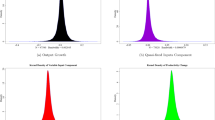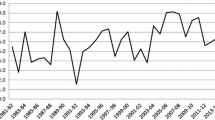Abstract
In this paper, we employ the less frequently used Geometric Young index to measure productivity change. We reformulate the Geometric Distance Function of Portela and Thanassoulis (J Product Anal 25:25–41, 2006) by removing the restrictions on the individual input scaling factors and the output scaling factors to obtain the benchmark input–output bundle on the frontier. In this reformulated model, the Geometric Young index is exhaustively decomposed into the technical efficiency change and technical change factors even under variable returns to scale. Further, between any two periods, the measured rate of technical change is identical across all units. In our empirical analysis, we use state-level data from the Annual Survey of Industries for the period 2010–2011 through 2016–2017 to measure total factor productivity growth in Indian manufacturing and provide its decomposition for the major manufacturing states in India. At the All-India level, the annual average Geometric Young productivity index shows a modest growth over the sample period. This resulted from an improvement in technical efficiency reinforced by a very modest increase in the Technical Change Index.



Similar content being viewed by others
Notes
For a detailed discussion of Index Numbers, see the survey by Rao (2020).
The data are reported by accounting year which runs from April 1 to March 31. For example, the year 2016–2017 refers to the period April 1, 2016, to March 31, 2017. Henceforth, for simplicity we will refer to it as year 2016 and similarly for the other years in our sample.
For an application of the Lowe productivity index and its decomposition, see O’Donnell (2012).
Use of the notation t and t + 1 to denote adjacent periods is the generalization of the notation 0 and 1 used in previous discussion.
They recognize, though, that ‘the GDF in (4) used to calculate TFP is not an efficiency measure as it does not account for distances between observed and target levels but between two points observed in two time periods’ (PT 2006, p. 30).
In PT (2006), there is no explicit restriction on the input and output scaling factors. In fact, they do not algebraically formulate the production possibility set empirically constructed from the data. But as shown in this paper, the residual component (which they describe as ‘scale-related’) will equal unity even under VRS unless the inputs scaling factors are restricted from above and output scaling factors are restricted from below at 1. In another paper PT (2007), they explicitly impose these restrictions in Eq. (3) where they measure technical efficiency. Later, in the same paper, for the standard profit maximization problem (4) (PT 2007, p 483), they remove these restrictions. But that is unrelated to the GDF.
This result was first presented in a preliminary form in Ray and Chen (2009) and later in Ray and Chen (2014). More recently, Aparicio et al. (2017) derive a decomposition of the Geometric Young index without the residual scale factor (although they describe this as a geometric mean of partial Malmquist productivity changes). However, they assume CRS (see their slide 7) which automatically rules out the scale factor.
In our empirical analysis, we applied this iterative process. In most cases, the optimal solution converged at the second iteration. Only in a very few cases, convergence took place at the third or fourth iteration.
The importance of other factors in determining productivity growth and performance has also been highlighted in the literature. For example, Aghion et al. (2008) and Veermani and Goldar (2004) emphasize that states with better investment climate experienced higher productivity growth in Indian manufacturing during the post-reform years.
As mentioned previously, this refers to the accounting years 2010–2011 to 2016–2017.
The corresponding percentages for these eight states were 71%, 73%, and 71% in 2011. The drop in percentage share between 2011 and 2016 could be partly due to the fact that in 2014 there was a geographic reorganization of the states and the state of Andhra Pradesh (AP) was broken up into two states—Andhra Pradesh (AP) and Telangana (TE).
It may be noted that in manufacturing the material input typically accounts for an overwhelmingly large share of production cost. For example, in the year 2007 for the U.S. states the average share was 67%, varying between 51% for Connecticut (CT) and 79% for Delaware (DE).
We thank an anonymous referee for this suggestion.
Here, labor productivity is measured by output per person employed, without distinguishing between production and non-production workers.
In this single-output case, the output index is simply the ratio of real values of gross outputs in consecutive years.
Note that Table 5 does not report the decomposition for ‘All India.’ This is because our decision-making units are the ‘typical factory’ in each of the 26 states. The typical factory in ‘All India’ is not included as an individual unit. However, from the annual Geometric Young productivity index reported in Table 4 and given the annual Technical Change Index in Table 5, which is uniform across all units, we can impute the Technical Efficiency Change Index for the typical factory at the All-India level.
Although in our empirical analysis, the cost shares remained very stable over our sample period, this may not always be true if there are shocks that cause these shares to fluctuate over the sample period. Given the crucial role of these reference weights in using the Geometric Young productivity index, it may be a worthwhile practice in general to utilize alternative sets of reference weights to check for robustness of results.
References
Aghion P, Burgess R, Redding S, Zilibotti F. The unequal effects of liberalization: evidence from dismantling the license Raj in India. Am Econ Rev. 2008;98(4):1397–412.
Aparicio J, Pastor JT, Mahlberg B. Total factor productivity change based on partial productivities. Paper presented at the European workshop on efficiency and productivity analysis held in London, UK; 2017.
Caves DW, Christensen LR, Diewert WE. The economic theory of index numbers and the measurement of inputs. Outputs Product Econom. 1982;50:1393–414.
Das DK, Kalita G. Aggregate productivity growth in indian manufacturing: an application of Domar aggregation. Working paper no. 239, Indian Council for Research on International Economic Relations, New Delhi; 2009
Deb AK. Economic reforms, capacity utilization and productivity growth in Indian manufacturing. Glob Bus Rev. 2014;15(4):719–46.
Deb AK, Ray SC. Total factor productivity growth in Indian manufacturing: a biennial Malmquist analysis of inter-state data. Indian Econ Rev. 2014;49(1):1–25.
Färe R, Grosskopf S, Lindgren B, Roos P. Productivity changes in Swedish pharmacies 1980–1989: a non-parametric Malmquist approach. J Prod Anal. 1992;3:85–101.
Färe R, Grosskopf S, Norris M, Zhang Z. Productivity growth, technical progress and efficiency change in industrialized countries. Am Econ Rev. 1994;84:66–83.
Goldar B. Indian manufacturing: productivity trends in pre- and post-reform periods. Econ Polit Wkly. 2004;39(46/47):5033–43.
Goldar B, Kumari A. Import liberalization and productivity growth in Indian manufacturing industries in the 1990s. Dev Econ. 2003;41:436–60.
Government of India, Annual Survey of Industries, Ministry of Statistics and Program Implementation (MOSPI). Various Issues.
Kim S, Saravanakumar M. Economic reform and total factor productivity growth in Indian manufacturing industries. Rev Dev Econ. 2012;16(1):152–66.
Lovell C. The decomposition of malmquist productivity indexes. J Product Anal. 2003;20(3):437–58.
O’Donnell CJ. Nonparametric estimates of the components of productivity and profitability change in U.S. agriculture. Am J Agric Econ. 2012;94(4):873–90.
O’Donnell CJ. Using information about technologies, markets and firm behavior to decompose a proper productivity index. J Econom. 2016;190:328–40.
Portela MCAS, Thanassoulis E. Profit efficiency in DEA. Aston Business School Research Paper RP0206, ISBN 185449502X, University of Aston, Aston Triangle, Birmingham B4 7ET, UK; 2002.
Portela MCAS, Thanassoulis E. Malmquist indexes using a geometric distance function (GDF). Application to a sample of Portuguese bank branches. J Product Anal. 2006;25:25–41.
Portela MCAS, Thanassoulis E. Developing a decomposable measure of profit efficiency using DEA. J Oper Res Soc. 2007;58(4):481–90.
Rao DSP. Index numbers and productivity measurement. In: Ray SC, Chambers RG, Kumbhakar S, editors. Handbook of production economics, vol. I. Berlin: Springer; 2020 (forthcoming).
Rath BN. Productivity growth and efficiency change: comparing manufacturing- and service-based firms in India. Econ Model. 2018;70:447–57.
Ray SC. Regional variation in productivity growth in Indian manufacturing: a nonparametric analysis. J Quant Econ. 1997;13(1):73–94.
Ray SC. Did India’s economic reforms improve efficiency and productivity? A nonparametric analysis of the initial evidence from manufacturing. Indian Econ Rev. 2002;37(1):23–57.
Ray SC. Data envelopment analysis: theory and techniques for economics and operations research. New York: Cambridge University Press; 2004.
Ray SC, Chen L. Pareto Koopmans efficiency and a Tornqvist productivity index: an application to dental care in the US. Paper presented at the OR51 Conference in Warwick, UK; 2009.
Ray SC, Chen L. A normative interpretation of the Tornqvist productivity index. Paper presented at the 7th North American Productivity Workshop in Ottawa, Canada; 2014.
Ray SC, Desli E. Productivity growth, technical progress, and efficiency change in industrialized countries: comment. Am Econ Rev. 1997;87–5:1033–9.
Ray SC, Ghose A. Production efficiency in indian agriculture: an assessment of the post green revolution years. Omega. 2014;44:58–69.
Ray SC, Jeon Y. Reputation and efficiency: a non-parametric assessment of America’s top-rated MBA programs. Eur J Oper Res. 2008;189(1):245–68.
Shephard RW. Cost and production functions. Princeton: Princeton University Press; 1953.
Shephard RW. Theory of cost and production functions. Princeton: Princeton University Press; 1970.
Trivedi P. An inter-state perspective on manufacturing productivity in India: 1980–1981 to 2000–2001. Indian Econ Rev. 2004;39:203–37.
Trivedi P, Lakshmanan L, Jain R, Gupta YK. Productivity, efficiency and competitiveness of the Indian manufacturing sector. Reserve Bank of India, Department of Economic and Policy Research’ Study No. 37; 2011.
Veermani C, Goldar B. Investment climate and total factor productivity in manufacturing: analysis of Indian states. Working Paper No. 127, Indian Council for Research on International Economic Relations, New Delhi; 2004.
Acknowledgements
The authors thank two anonymous referees and the editors for valuable comments on an earlier version of the manuscript. The usual disclaimer applies.
Author information
Authors and Affiliations
Corresponding author
Additional information
Publisher's Note
Springer Nature remains neutral with regard to jurisdictional claims in published maps and institutional affiliations.
Rights and permissions
About this article
Cite this article
Ray, S.C., Deb, A.K. & Mukherjee, K. Unrestricted geometric distance functions and the Geometric Young productivity index: an analysis of Indian manufacturing. Empir Econ 60, 3103–3134 (2021). https://doi.org/10.1007/s00181-020-01925-0
Received:
Accepted:
Published:
Issue Date:
DOI: https://doi.org/10.1007/s00181-020-01925-0
Keywords
- Geometric Distance Functions
- Geometric Young productivity index
- Total factor productivity growth
- Data envelopment analysis
- Technical change
- Indian manufacturing




